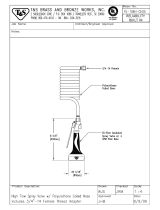
15
For Indoor Hot Water/Burner Use
Exhaust:
Hot fumes from burner must be exhausted
through a hood or piped to the outside.
Place the unit so that the exhaust fumes will not
be directed towards people or building air intakes.
Precautions:
Keep a fire extinguisher rated “ABC” nearby.
Keep it properly charged and be familiar with its
use.
Ensure that working, battery-operated or battery
back-up carbon monoxide alarms are used in any
structure that is in close proximity to the running
pressure washer.
An abundant amount of air must be available for
proper combustion and cooling. Do not install in
small, enclosed areas without an ample
circulation of supply air.
For more details, refer to NFPA 31: Standard for
the Installation of Oil-Burning Equipment.
Chapter 5 provides guidelines on how to ensure
adequate air is provided for safe combustion.
DANGER: Carbon monoxide poisoning
hazard
Exhaust fumes from the burner contain carbon
monoxide (CO), a poisonous gas you cannot see,
smell, or taste. The CO generated by the pressure
washer can rapidly accumulate, even in areas that
appear to be well ventilated, resulting in dangerous and
fatal concentrations within minutes. ONLY run pressure
washer outdoors and away from air intakes. NEVER run
pressure washer inside any enclosed or semi-enclosed
spaces, including homes, garages, basements, sheds,
boxes, pick-up truck beds, RVs, or boats. These spaces
can trap poisonous gases, EVEN if you run a fan or
open windows. If you start to feel sick, dizzy, or weak
while using the pressure washer, shut off the motor and
get to fresh air RIGHT AWAY. See a doctor. You may
have carbon monoxide poisoning.
Operation
Step 1. Connect Hoses, Water Supply, and
Spray Nozzle
Note: The electrical power and pump are both off
during Step 1 procedures.
Hose and Water Supply
Water supply should be standard, clean, tap water.
To allow adequate flow and pressure, acquire a 5/8”
flexible garden hose (3/4” if over 100 ft. long).
Note: A backflow preventer at the water supply is
recommended and may be required by local code.
Attach garden hose to water supply, making sure
hose is not kinked.
Flow rate at end of supply hose should be 3.0 gpm or
higher and between 20-100 psi, depending on model.
Connect Water Supply to Pump
Confirm rubber washer and inlet filter screen are in
water pump inlet. (See #2 in “Component
Identification” section for location of water inlet)
Run water through garden hose for 30 seconds to
clean out debris. Turn off water.
Connect garden hose to water pump inlet on
pressure washer and turn on water valve.
Connect Pressure Hose to Pump
Uncoil high-pressure hose. Attach quick connect end of
hose to pressure washer’s water outlet and other end of
high-pressure hose to spray gun by following the “Quick
Connect Procedure” below.
WARNING: Incompatable component
hazard
NEVER operate this pump with components (such as
hose, connections, and spray gun) rated for lower
pressure and/or temperature limits than the machine’s
maximum rated pressure and temperature, or
component will likely rupture and cause serious
personal injury from escaping high pressure fluids.
Quick Connect Procedure
Pull quick connect collar back (Figure 9a).
Push hose or nozzle firmly against stop.
Let go of collar (Figure 9a).
Pull (hose or nozzle) to assure a tight connection.
WARNING: Projectile hazard
Sprayer nozzle can become a projectile and cause
serious personal injury or damage if not properly
connected to the spray gun.























